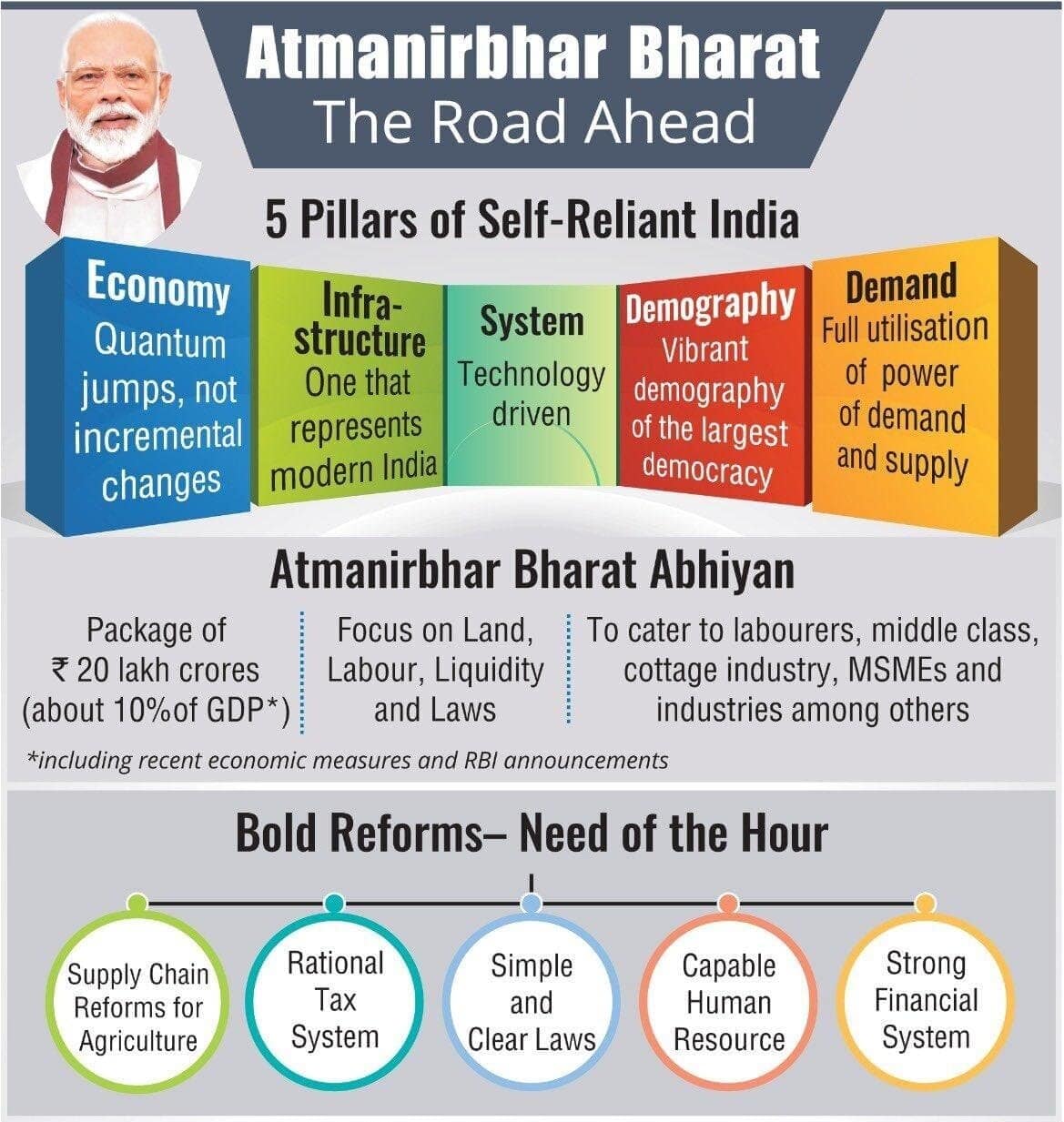Atma Nirbhar Bharat Abhiyan: Challenges | 21 May 2020
This article is based on “Atmanirbhar Bharat Abhiyaan lays strong foundations for raising our per capita GDP” which was published in the Indian Express on 18/05/2020. It talks about several challenges pertaining to Atma Nirbhar Bharat Abhiyan.
Recently, the government announced an economic stimulus package of Rs 20 lakh crore and big-bang systemic reforms under the Atma Nirbhar Bharat Abhiyan (self-reliant India).
The intended objective of this plan is two-fold. First, interim measures such as liquidity infusion and direct cash transfers for the poor will work as shock absorbers for those in acute stress.
The second, long-term reforms in growth-critical sectors to make them globally competitive and attractive.
Together, these steps may revive the economic activity, impacted by Covid-19 pandemic and create new opportunities for growth in sectors like agriculture, micro, small and medium enterprises (MSMEs), power, coal and mining, defence and aviation,etc.
However, there are several challenges that are needed to be addressed in order to fulfill the vision of this plan.
Impact of this Stimulus Package
- Primary Sector: The measures (reforms to amend ECA, APMC, Contract framing, etc) announced for the agricultural and allied sectors are particularly transformative.
- These reforms are steps towards the One Nation One Market objective and help India become the food factory of the world.
- These would finally help in achieving the goal of a self-sustainable rural economy.
- Also, the MGNREGA infusion of Rs 40,000 crore may help in alleviating the distress of migrants when they return to their villages.
- Secondary Sector: Given the importance of MSMEs for Indian economy, the Rs 3 lakh crore collateral-free loan facility for MSMEs under the package will help this finance-starved sector and thereby provide a kickstart to the dismal state of the economy.
- Also, as the MSME sector is the second largest employment generating sector in India, this step will help to sustain the labour intensive industries and thereby help in leveraging India’s comparative advantage.
- Additionally, limiting imports of weapons and increasing the limit of foreign direct investment in defence from 49% to 74% will give a much-needed boost to the production in the Ordnance Factory Board, while reducing India’s huge defence import bill.
- Tertiary Sector: The government has adopted a balanced approach in addressing concerns across sectors. For example:
- The newly launched PM e-Vidya programme for multi-mode access to digital online education provides a uniform learning platform for the whole nation, which shall enable schools and universities to stream courses online without further loss of teaching hours.
- Public expenditure on health will be increased by investing in grass root health institutions and ramping up health and wellness centres in rural and urban areas.
Associated Challenges
- Issues Related to Liquidity: The package of Rs 20 lakh crore comprises both fiscal and monetary measures, the latter being in the nature of credit guarantees and liquidity infusions into banks and other financial sector institutions rather than the economy per se.
- Majority of the package is liquidity measures that are supposed to be transmitted by RBI to Banks and Banks to Citizens. This transmission wouldn’t be as smooth owing to inefficient transmission of monetary policy.
- Lack of Demand: The lockdown has lowered aggregate demand, and a fiscal stimulus is needed. However, the package, by relying overwhelmingly on credit infusion to boost the economy, has failed to recognise that investment will pick up only when people across income segments have money to spend.
- Lack of Backward and Forward Linkages: Unless the rest of the domestic economy is revived, the MSME sector may face a shortage of demand, and its production may soon sputter to a close.
- Burgeoning Fiscal Deficit: Government claims that the stimulus package is around 10% of India’s GDP. However, financing it would be difficult as the government is worried about containing the fiscal deficit.
- Difficulty in Mobilising Finances: The government seeks a disinvestment to mobilise the finances for the plan.
- However, the majority of Indian industries are already a bit debt-laden to take up the stake in PSUs.
- Further, it is difficult to borrow the foriegn markets, as rupee with respect to dollar is all time low.
Steps To Be Taken
- Enhancing Demand: The economic package for the country emerging out of the lockdown requires a stimulus enhancing demand across the economy.
- The best way for this is to spend on greenfiled infrastructure.
- Infrastructure spending uniquely creates structures that raise productivity and extends spending power to the section of the population most affected by the lockdown, namely daily wage labourers.
- Mobilising Finances: For financing of the stimulus package, India’s foreign reserves stand at an all-time high which could be strategically used to finance its needs.
- The rest may have to come from privatisation, taxation, loans and more international aid.
- Holistic Reforms: Any stimulus package will fail to reflect the trickle-down effect, until and unless it is backed by reforms in various sectors.
- Thus, Atma nirbhar plan also encompasses the unfinished agenda of holistic reforms which may include reforms in Civil services, Education,Skill and Labour, etc.
Conclusion
The economic crisis triggered by Covid-19 pandemic is much like the 1991 economic crisis, which was a harbinger of a paradigm shift via liberalisation, privatisation and globalisation. The post-Covid-19 era may usher in unprecedented opportunities provided the implementation deficit is adequately addressed.
|
Drishti Mains Question “Any financial stimulus package will fail to reflect the trickle-down effect unless it is backed by reforms in other sectors”. Discuss the statement in context of Atma Nirbhar Bharat Abhiyan. |
This editorial is based on “One conflict less” which was published in The Indian Express on May, 20th 2020. Now watch this on our Youtube channel.

